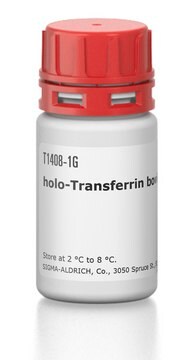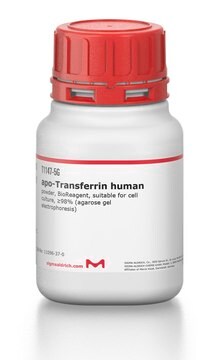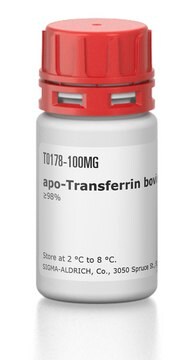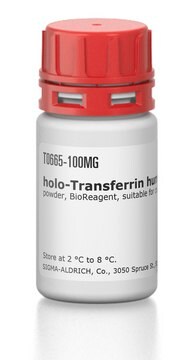T1283
holo-Transferrin Rind
Iron-saturated, BioReagent, suitable for cell culture
Synonym(e):
Siderophilin, Siderophilin, eisengesättigt
About This Item
Empfohlene Produkte
Produktlinie
BioReagent
Assay
97-100% (agarose gel electrophoresis)
Form
powder
Konzentration
~25 mM
Methode(n)
cell culture | mammalian: suitable
Verunreinigungen
endotoxin, tested
Löslichkeit
H2O: 50 mg/mL
UniProt-Hinterlegungsnummer
Versandbedingung
ambient
Lagertemp.
2-8°C
Angaben zum Gen
bovine ... TF(280705)
Suchen Sie nach ähnlichen Produkten? Aufrufen Leitfaden zum Produktvergleich
Anwendung
Hinweis zur Analyse
Lagerklassenschlüssel
11 - Combustible Solids
WGK
WGK 3
Flammpunkt (°F)
Not applicable
Flammpunkt (°C)
Not applicable
Persönliche Schutzausrüstung
Eyeshields, Gloves, type N95 (US)
Hier finden Sie alle aktuellen Versionen:
Besitzen Sie dieses Produkt bereits?
In der Dokumentenbibliothek finden Sie die Dokumentation zu den Produkten, die Sie kürzlich erworben haben.
Kunden haben sich ebenfalls angesehen
Artikel
How transferrin and other cell culture components affect the performance of serum-free, protein-free cell culture systems used for biomanufacturing heterologous proteins including monoclonal antibodies. The page introduces the in vitro chemistry and biochemistry of transferrin.
Unser Team von Wissenschaftlern verfügt über Erfahrung in allen Forschungsbereichen einschließlich Life Science, Materialwissenschaften, chemischer Synthese, Chromatographie, Analytik und vielen mehr..
Setzen Sie sich mit dem technischen Dienst in Verbindung.












